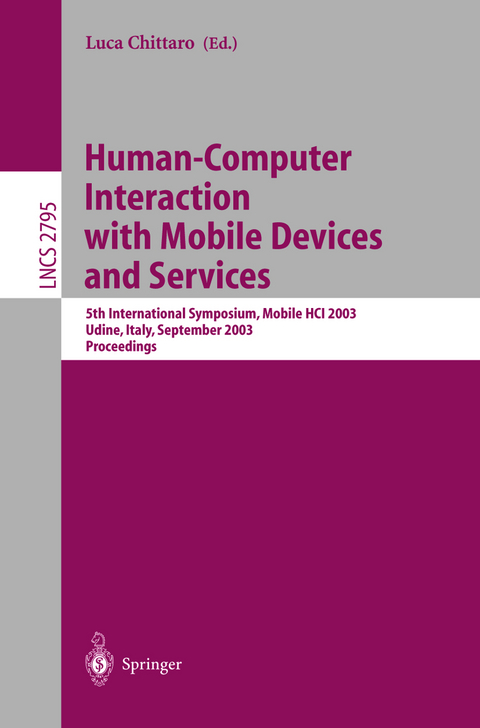
Human-Computer Interaction with Mobile Devices and Services
Springer Berlin (Verlag)
978-3-540-40821-5 (ISBN)
Keynote Speakers.- People versus Information: The Evolution of Mobile Technology.- The Zen of Everyday Encounters: Spontaneous Interaction in Ubiquitous Systems.- Studying Mobile Users in Their Natural Contexts.- Understanding Mobile Contexts.- Motorcyclists Using Hocman - Field Trials on Mobile Interaction.- Connecting Remote Visits and Design Environment: User Needs and Prototypes for Architecture Design.- Everyday Wearable Computer Use: A Case Study of an Expert User.- Input Techniques for Mobile Devices.- Using Mobile Keypads with Limited Visual Feedback: Implications to Handheld and Wearable Devices.- Time-Out in Mobile Text Input: The Effects of Learning and Feedback.- SyncTap: An Interaction Technique for Mobile Networking.- Location-Aware Guides and Planners.- Experiments with Multi-modal Interfaces in a Context-Aware City Guide.- Design Criteria for Location-Aware, Indoor, PDA Applications.- The Design and Evaluation of a Mobile Location-Aware Handheld Event Planner.- Bringing Mobile Services to Groups in Workplaces.- Supporting Local Mobility in Healthcare by Application Roaming Among Heterogeneous Devices.- Aligning Work Practices and Mobile Technologies: Groupware Design for Loosely Coupled Mobile Groups.- Encouraging Face-to-Face Collaborative Learning through the Use of Handheld Computers in the Classroom.- Mobile Gaming.- Human Pacman: A Mobile Entertainment System with Ubiquitous Computing and Tangible Interaction over a Wide Outdoor Area.- OpenTrek: A Platform for Developing Interactive Networked Games on Mobile Devices.- Tools and Frameworks for Mobile Interface Design and Generation.- Supporting Efficient Design of Mobile HCI.- Dygimes: Dynamically Generating Interfaces for Mobile Computing Devices and Embedded Systems.- Online Transcoding of WebPages for Mobile Devices.- Multi-modal Framework to Support Users with Special Needs in Interaction with Public Information Systems.- Usability and HCI Research Methods.- Usability Evaluations for Multi-device Application Development Three Example Studies.- A Review of Mobile HCI Research Methods.- Short Talks.- Exploring the Utility of Remote Messaging and Situated Office Door Displays.- TimeMachine Oulu - Dynamic Creation of Cultural-Spatio-Temporal Models as a Mobile Service.- Awase-E: Image-Based Authentication for Mobile Phones Using User's Favorite Images.- Older Users' Requirements for Location Based Services and Mobile Phones.- GentleGuide: An Exploration of Haptic Output for Indoors Pedestrian Guidance.- Sound Visualization and Retrieval Technique for Assisting Hearing Memory of Patrol Worker.- Constructing Public Discourse with Ethnographic/SMS "Texts".- A Customer Satisfaction Evaluation Model for Mobile Internet Services.- Designing Adaptive Mobile Applications: Abstract Components and Composite Behaviors.- Cinematic Techniques for Mobile Presentations.- Using a Mobile Device to Vary the Pace of Search.- Designing Advanced Mobile Applications Examples of UMTS Trial Applications.- iCAMS2: Developing a Mobile Communication Tool Using Location Information and Schedule Information with J2ME.- Understanding and Modeling Physical Environments for Mobile Location Aware Information Services.- SmartLibrary - Location-Aware Mobile Library Service.- Posters.- The Human Interface in Mobile Applications.- I'm Here!: A Wearable Object Remembrance Support System.- Towards a Framework to Develop Plastic User Interfaces.- Context-Aware Interaction in a Mobile Environment.- Platform Awareness in Dynamic Web User Interfaces Migration.- User Needs for Developmentof Context Dependent Devices in Mobile Home Care.- Context Information in Mobile Telephony.- Component Model and Programming: A First Step to Manage Human Computer Interaction Adaptation.- Mobile Tele-instruction Using Interactive Augmented Reality.- A Study on the Predicate Prediction Using Symbols in Augmentative and Alternative Communication System.- Electronic Navigation - Some Design Issues.- The Use of Statistically Derived Personas in Modelling Mobile User Populations.- M3I in a Pedestrian Navigation & Exploration System.- Mobile Devices: Opportunities for Users with Special Needs.
| Erscheint lt. Verlag | 21.8.2003 |
|---|---|
| Reihe/Serie | Lecture Notes in Computer Science |
| Zusatzinfo | XVI, 504 p. |
| Verlagsort | Berlin |
| Sprache | englisch |
| Maße | 155 x 235 mm |
| Gewicht | 760 g |
| Themenwelt | Mathematik / Informatik ► Informatik ► Betriebssysteme / Server |
| Informatik ► Software Entwicklung ► User Interfaces (HCI) | |
| Schlagworte | adaptive devices • augmented reality • HCI • Human-Computer interaction • Human Computer Interaction • Human-Computer Interaction (HCI) • Human Factors • information system • Mensch-Computer-Interaktion • mobile computing • Mobile Devices • Navigation • Pervasive Computing • programming • ubiquitous computing • Usability • User-Centered Design • Visualization |
| ISBN-10 | 3-540-40821-5 / 3540408215 |
| ISBN-13 | 978-3-540-40821-5 / 9783540408215 |
| Zustand | Neuware |
| Haben Sie eine Frage zum Produkt? |
aus dem Bereich


